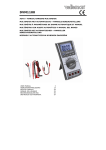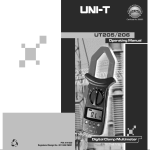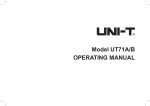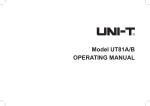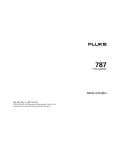Download Uni-Trend UT60G multimeter
Transcript
Model UT60F/G: OPERATING MANUAL Table of Contents Page Title Overview Unpacking Inspection Safety Information Rules For Safe Operation International Electrical Symbols The multimeter Structure Rotary Switch Functional Button Display Symbols Measurement Ranges Measurement Operation A. DC Voltage Measurement B. AC Voltage Measurement DC or AC Current Measurement C. Measuring Resistance D. Testing Diodes E. Testing for Continuity F. Capacitance Measurement G. H. Frequency Measurement Model UT60 G: Temperature I. Measurement Sleep Mode General Specifications Accuracy Specifications A. DC Voltage B. AC Voltage C. DC Current D. AC Current 1 3 4 5 6 8 9 10 11 13 15 17 17 18 19 21 23 24 26 27 29 30 31 32 32 32 33 33 Model UT60F/G: OPERATING MANUAL Title Page E. Resistance Diode Test F. Continuity Test G. H. Capacitance Frequency I. Temperature J. Maintenance A. General Service B. Replacing the Battery C. Replacing the Fuses 2 34 34 34 35 35 35 36 36 36 37 Model UT60F/G: OPERATING MANUAL Overview This Operating Manual covers information on safety and cautions. Please read the relevant information carefully and observe all the Warnings and Notes strictly. Warning To avoid electric shock or personal injury, read the "Safety Information" and "Rules for Safe Operation" carefully before using the Meter. Digital Multimeter Model UT60F/UT60G (hereafter referred to as “the Meter”) are 3 3/4 digits with steady operations, fashionable structure and highly reliable measuring instrument. The Meter uses large scale of integrated circuit with double integrated A/D converter as its core and has full range overload protection. The Meter can measure AC/DC Voltage, AC/DC Current, Resistance, Capacitance, Temperature, Frequency, Diodes, Continuity and etc. The Meter adopted advanced “co-injection” technique in order to provide sufficient insulation. In addition, the Display Backlight feature enables user to work in a dim condition. 3 Model UT60F/G: OPERATING MANUAL Unpacking Inspection Open the package case and take out the Meter. Check the following items carefully to see any missing or damaged part: Item 1 2 3 4 5 6 Description English Operating Manual Test Lead Test Clip Point Contact Temperature Probe (UT60G only) RS-232C Interface Cable CD-ROM (Installation Guide & Computer Interface Software) Qty 1 piece 1 pair 1 pair 1 piece 1 piece 1 piece In the event you find any missing or damage, please contact your dealer immediately. 4 Model UT60F/G: OPERATING MANUAL Safety Information This Meter complies with the standards IEC61010: in pollution degree 2, overvoltage category (CAT. III 1000V, CAT. IV 600V) and double insulation. CAT. III: Distribution level, fixed installation, with smaller transient overvoltages than CAT. IV CAT IV: Primary supply level, overhead lines, cable systems etc. Use the Meter only as specified in this operating manual, otherwise the protection provided by the Meter may be impaired. In this manual, a Warning identifies conditions and actions that pose hazards to the user, or may damage the Meter or the equipment under test. A Note identifies the information that user should pay attention on. International electrical symbols used on the Meter and in this Operating Manual are explained on page 8. 5 Model UT60F/G: OPERATING MANUAL Rules For Safe Operation (1) Warning To avoid possible electric shock or personal injury, and to avoid possible damage to the Meter or to the equipment under test, adhere to the following rules: l l l l l l l l l Before using the Meter inspect the case. Do not use the Meter if it is damaged or the case (or part of the case) is removed. Look for cracks or missing plastic. Pay attention to the insulation around the connectors. Inspect the test leads for damaged insulation or exposed metal. Check the test leads for continuity. Replace damaged test leads with identical model number or electrical specifications before using the Meter. Do not apply more than the rated voltage, as marked on the Meter, between the terminals or between any terminal and grounding. The rotary switch should be placed in the right position and no any changeover of range shall be made during measurement is conducted to prevent damage of the Meter. When the Meter working at an effective voltage over 60V in DC or 30V rms in AC, special care should be taken for there is danger of electric shock. Use the proper terminals, function, and range for your measurements. Do not use or store the Meter in an environment of high temperature, humidity, explosive, inflammable and strong magnetic field. The performance of the Meter may deteriorate after dampened. When using the test leads, keep your fingers behind the finger guards. Disconnect circuit power and discharge all highvoltage capacitors before testing resistance, continuity, diodes, current or capacitance. 6 Model UT60F/G: OPERATING MANUAL Rules For Safe Operation (2) l l l l l l l l l Before measuring current, check the Meter’s fuses and turn off power to the circuit before connecting the Meter to the circuit. Replace the battery as soon as the battery indicator appears. With a low battery, the Meter might produce false readings that can lead to electric shock and personal injury. Remove test leads, point contact temperature probe and RS232C interface cable from the Meter and turn the Meter power off before opening the Meter case. When servicing the Meter, use only the same model number or identical electrical specifications replacement parts. The internal circuit of the Meter shall not be altered at will to avoid damage of the Meter and any accident. Soft cloth and mild detergent should be used to clean the surface of the Meter when servicing. No abrasive and solvent should be used to prevent the surface of the Meter from corrosion, damage and accident. The Meter is suitable for indoor use. Turn the Meter off when it is not in use and take out the battery when not using for a long time. Constantly check the battery as it may leak when it has been using for some time, replace the battery as soon as leaking appears. A leaking battery will damage the Meter. 7 Model UT60F/G: OPERATING MANUAL International Electrical Symbols AC (Alternating Current). DC (Direct Current). AC or DC. Grounding. Double Insulated. Deficiency of Built-In Battery. Continuity Test. Diode. Fuse. Warning. Refer to the Operating Manual. Conforms to Standards of European Union. 8 Model UT60F/G: OPERATING MANUAL The multimeter Structure (see figure 1) 5 6 1 2 3 4 ( figure 1) LCD Display Functional Buttons Rotary Switch HzVΩInput Terminal: Input for voltage, frequency, resistance,diode, capacitance and continuity measurements. 5 COM Input Terminal: Return terminal for all measurements. 6 Model UT60F: µA mA Input Terminal; Input for µA and mA measurement. o Model UT60G: mA C Input Terminal Input for mA and temperature measurement. 7 10A Input Terminal Input for A measurement. 9 Model UT60F/G: OPERATING MANUAL Rotary Switch Below table indicated for information about the rotary switch positions. Rotary Switch Function Position AC or DC voltage measurement V Hz o C µA mA A : Resistance measurement : Diode test : Continuity test Capacitance measurement Frequency measurement Temperature measurement (UT60G only) AC or DC current measurement range from 0.1µA to 4.000mA (UT60F only) Model UT60F: AC or DC current measurement range from 0.01mA to 400.0mA Model UT60G: AC or DC current measurement range from 0.01mA to 600.0mA. AC or DC current measurement range from 10mA to 10.00A 10 Model UT60F/G: OPERATING MANUAL Functional Button(1) Below table indicated for information about the functional button operations. Button Measuring Function Operation Performed once to turn the Display Display Press Backlight Backlight on and it shall shut off automatically in around 60 seconds later. V Switches between AC and DC Voltage; the Meter beeps. DC is default. Switches between continuity and diode and resistance measurement; (BLUE) The Meter beeps. Resistance is default. Switches between AC and DC µA current range from 0.1µA to (UT60F 4.000mA; the Meter beeps. DC ONLY) is default Model UT60F: Switches between AC and DC current measurement range from 0.01mA to 400.0mA; mA the Meter beeps. DC is default. Model UT60G: Switches between AC and DC current measurement range from 0.01mA to 600.0mA ; the Meter beeps. DC is default. Any rotary 1.Press RANGE to enter the RANGE manual ranging mode; the Meter Switch beeps. Position Manually selecting a range causes the Meter to exit the Hold mode. 2.Press RANGE to step through the ranges available for the selected function; the Meter beeps. 3.Press and hold RANGE for over 1 second to return to autoranging; the Meter beeps. 11 Model UT60F/G: OPERATING MANUAL Functional Button(2) Any rotary Press HOLD H to enter and exit Switch the Hold mode in any mode, the Position Meter beeps. HOLDH At OFF position l Press and hold HOLD H button while turning on the Meter to display full icons. l Press HOLD H again to return to normal display mode. Any rotary Turn the Meter’s power on and off. Switch Position Any rotary Turn on or off the serial port RS232C switch interface without changing the position original setting. Although HOLD H is on, outputted data displayed on the computer is the current measurement value. POWER 12 Model UT60F/G: OPERATING MANUAL Display Symbols(1) (see figure 2) 4 3 5 6 7 16 8 RS232C 1 14 DC 2 AC C F nµmF µmVA Mk Ω Hz 15 9 10/11 12/13 ( figure 2) Number 1 2 3 4 5 Symbol Meaning DC Indicator for DC voltage or current AC Indicator for AC voltage or current The Meter is in the auto range mode in which the Meter autom atically selects the range with the best resolution. RS232C Data output is in progress Data hold is active AUTO 6 7 8 9 Test of diode The continuity buzzer is on o o C F nF,µF, mF The unit of temperature: Centigrade temperature Fahrenheit temperature Farad. The unit of capacitance nF: Nanofarad. 1x10-9 or 0.000000001 farads. µF:Microfarad.1x10-6 or 0.000001 farads. mF: Millifarad. 1x10-3 or 0.001 farads. 13 Model UT60F/G: OPERATING MANUAL Display Symbols(2) (see figure 2) 10 11 12 13 14 µA,mA A Amperes (amps). The unit of current. mA: Milliamp, 1x10-3 or 0.001 amperes. µA:Microamp.1x10-6 or 0.000001 amperes. Volts. The unit of voltage. mV: Millivolt. 1x10-3 or 0.001 volts Ω:Ohm. The unit of resistance. Ω,kΩ, kΩ:Kilohm. 1x103 or 1000 ohms MΩ MΩ:Megaohm. 1x106 or 1,000,000 ohms Hertz. The unit of frequency in Hz, kHz, cycles/second. kHz: Kilohertz. 1x103 or MHz 1000 hertz MHz: Megahertz. 1x10 6 or 1,000,000 hertz Indicates negative reading mV, V 15 Sleep Mode feature is enabled. 16 The battery is low. Warning: To avoid false readings, which could lead to possible electric shock or personal injury, replace the battery as soon as the battery indicator appears. OL The input value is too large for the selected range 14 Model UT60F/G: OPERATING MANUAL Measurement Ranges(1) A measurement range determines the highest value the Meter can measure. Most Meter functions have more than one range. See “Accuracy Specifications.” A. Selecting a Measurement Range Being in the right measurement range is important: l If the range is too low for the input, the Meter displays OL to indicate an overload. l If the range is too high, the Meter will not display the most accurate measurement. B. Manual Ranging and Autoranging The Meter has both manual range and autorange options: l In the autorange mode, the Meter selects the best range for input signals. This allows you to switch test points without having to reset the range. l In the manual range mode, you may select the range. This allows you to override autorange and lock the Meter in a specific range. The Meter defaults to the autorange mode in measurement functions that have more than one range. When the Meter is in the autorange mode, is displayed. To enter and exit the manual range mode: 1. Press RANGE. The Meter enters the manual range mode and turns off. Each presses of RANGE increments the range. When the highest range is reached, The Meter wraps to the lowest range. 2.To exit the manual range model, press and hold RANGE for over 1 second. 15 Model UT60F/G: OPERATING MANUAL Measurement Ranges(2) The Meter returns to the autorange mode and displayed. is Note l If you manually change the measurement range after entering the Hold recording modes, the Meter exits these modes. 16 Model UT60F/G: OPERATING MANUAL Measurement Operation(1) A. DC Voltage Measurement (see figure 3) Select red black ( figure 3) Warning To avoid harms to you or damages to the Meter from eletric shock, please do not attempt to measure voltages higher than 1000V, although readings may be obtained. The DC Voltage ranges are: Model UT60F: 400mV, 4V, 40V, 400V and 1000V; Model UT60G: 600mV, 6V, 60V, 600V and 1000V. To measure DC voltage, connect the Meter as follows: 1. Insert the red test lead into the HzVΩ terminal and the black test lead into the COM terminal. 2. Set the rotary switch to V ;DC measurement is default or press BLUE button to select DC measurement mode. 3. Connect the test leads across with the object being measured. The measured value shows on the display. 17 Model UT60F/G: OPERATING MANUAL Measurement Operation(2) Note l In each range, the Meter has an input impedance of 10MΩ . This loading effect can cause measurement errors in high impedance circuits. If the circuit impedance is less than or equal to 10kΩ , the error is negligible (0.1 or less). l When DC voltage measurement has been completed, disconnect the connection between the testing leads and the circuit under test and remove testing leads from the input terminals. B. AC Voltage Measurement (see figure 4) Select red black ( figure 4) Warning To avoid harms to you or damages to the Meter from eletric shock, please do not attempt to measure voltages higher than 1000V rms, although readings may be obtained. The AC Voltage ranges are: Model UT60F: 400mV,4V,40V,400V and 1000V; Model UT60G: 600mV, 6V, 60V, 600V and 1000V. To measure AC voltage, connect the Meter as follows: 1. Insert the red test lead into the HzVΩ terminal and the black test lead into the COM terminal. 18 Model UT60F/G: OPERATING MANUAL Measurement Operation(3) 2. Set the rotary switch to V ; and press BLUE button to select AC measurement mode. 3. Connect the test leads across with the object being measured. The measured value shows on the display. Note l In each range, the Meter has an input impedance of 10MΩ. This loading effect can cause measurement errors in high impedance circuits. If the circuit impedance is less than or equal to 10kΩ, the error is negligible (0.1 or less). l When AC voltage measurement has been completed, disconnect the connection between the testing leads and the circuit under test and remove testing leads from the input terminals. C. DC or AC Current Measurement (see figure 5) Select DC or AC black red ( figure 5) Warning If the fuse burns out during measurement, the Meter may be damaged or the operator himself may be hurt. Use proper terminals, function and range for the measurement. When the testing leads are connected to the current terminals, do not parallel them across any circuit. 19 Model UT60F/G: OPERATING MANUAL Measurement Operation(4) Use the 10A terminal and A range if the current value to be tested is an unknown. Model UT60F has 3 measurement positions on the rotary switch: µA , mA and A . Model UT60G has 2 measuremnet positions on the rotary switch: mA and A . To measure current, do the following: 1. Model UT60F: Insert the red test lead into the µAmA or 10A terminal and the black test lead into the COM terminal. Model UT60G: Insert the red test lead into the o mA C or 10A terminal and the black test lead into the COM terminal. 2. Set the rotary switch toµA , mA, or A The Meter defaults to DC current measurement mode. To toggle between DC and AC current measurement function, press the BLUE button. 3. Connect the test leads with the object being measured. The measured value shows on the display Note: l For safety sake, the measuring time for high current should be less than 10 seconds for each measurement and the interval time between 2 measurements should be greater than 15 minutes. l When current measurement has been completed, disconnect the connection between the testing leads and the circuit under test and remove testing leads from the input terminals. 20 Model UT60F/G: OPERATING MANUAL Measurement Operation(5) D. Measuring Resistance (see figure 6) Select red black ( figure 6) Warning To avoid harms to you, please do not attempt to measure voltages higher than 60V DC or 30V rms AC. To avoid damages to the Meter or to the devices under test, disconnect circuit power and discharge all the high-voltage capacitors before measuring resistance. The resistance ranges are: Model UT60F: 400Ω, 4kΩ, 40kΩ, 400kΩ, 4MΩ, and 40MΩ. Model UT60G: 600Ω, 6kΩ, 60kΩ, 600kΩ, 6MΩ, and 60MΩ. To measure resistance, connect the Meter as follows: 1. Insert the red test lead into the HzVΩ terminal and the black test lead into the COM terminal. 2. Set the rotary switch toΩ resistance measurement (Ω) is default or press BLUE button to select Ω measurement mode. 3. Connect the test leads across with the object being measured. The measured value shows on the display. 21 Model UT60F/G: OPERATING MANUAL Measurement Operation(6) Note: l The test leads can add 0.1Ω to 0.2Ω of error to resistance measurement. To obtain precision readings in low-resistance measurement (UT60F: 400Ω and UT60G is 600Ω), short-circuit the input terminals beforehand and record the reading obtained (called this reading as X). Then use the equation: measured resistance value (Y) –(X) = precision readings of resistance. l For high-resistance measurement (>1MΩ), it is normal taking several seconds to obtain a stable reading. l If Ω reading with shorted test leads is not 0.5Ω, check for loose test leads, wrong function selected, or enabled data hold function. l The LCD displays OL indicating open-circuit or the tested resistor value is higher than the maximum range of the Meter. l Resistance measurement is default to auto range mode. AtΩ range, open circuit voltage approximate 1.20V. At all other range, open circuit voltage approximate 0.45V. l When resistance measurement has been completed, disconnect the connection between the testing leads and the circuit under test and remove testing leads from the input terminals. 22 Model UT60F/G: OPERATING MANUAL Measurement Operation(7) E.Testing Diodes (see figure 7) Select red black ( figure 7) Warning To avoid harms to you, please do not attempt to measure voltages higher than 60V DC or 30V rms AC. To avoid damages to the Meter or to the devices under test, disconnect circuit power and discharge all the high-voltage capacitors before testing diodes. Use the diode test to check diodes, transistors, and other semiconductor devices. The diode test sends a current through the semicondutor junction, then measure the voltage drop across the junction. A good silicon junction drops between 0.5V and 0.8V To test the diode out of a circuit, connect the Meter as follows: 1. Insert the red test lead into the HzVΩ terminal and the black test lead into the COM terminal. 2. Set the rotary switch toΩ and press BLUE button to select measurement mode. 3. For forward voltage drop readings on any semiconductor component, place the red test lead on the component’s anode and place the black test lead on the component’s cathode. The red test lead polarity is “+” while the black test lead polarity is “-” . 23 Model UT60F/G: OPERATING MANUAL Measurement Operation(8) Note l In a circuit, a good diode should still produce a forward voltage drop reading of 0.5V to 0.8V; however, the reverse voltage drop reading can vary depending on the resistance of other pathways between the probe tips. l Connect the test leads to the proper terminals as said above to avoid error display. l The LCD will display OL indicating either open circuit or wrong polarity connection. l The unit of diode is volt (V), displaying the positiveconnection voltage-drop value. l Diode test has only auto range mode, open circuit voltage approximate 3V. l When diode testing has been completed, disconnect the connection between the testing leads and the circuit under test and remove testing leads from the input terminals. F. Testing for Continuity (see figure 8) Select red ( figure 8) 24 black Model UT60F/G: OPERATING MANUAL Measurement Operation(9) Warning To avoid harms to you, please do not attempt to measure voltages higher than 60V DC or 30V rms AC. To avoid damages to the Meter or to the devices under test, disconnect circuit power and discharge all the high-voltage capacitors before measuring continuity. To test for continuity, connect the Meter as follows: 1. Insert the red test lead into the HzVΩ terminal and the black test lead into the COM terminal. 2. Set the rotary switch toΩ and press BLUE button to select measurement mode. 3. The buzzer sounds if the resistance of a circuit under test is less than 70Ω, The LCD simultaneous displays the two ends' of the tested circuit resistance value. Note l The LCD displays OL indicating the circuit being tested is open. l The testing range of continuity is fixed as: UT60F: 400.0Ω UT60G: 600.0Ω The open circuit voltage approximate 1.2V. l When continuity testing has been completed, disconnect the connection between the testing leads and the circuit under test and remove testing leads from the input terminals. 25 Model UT60F/G: OPERATING MANUAL Measurement Operation(10) G. Capacitance Measurement (see figure 9) red black ( figure 9) Warning To avoid harms to you, please do not attempt to measure voltages higher than 60V DC or 30V rms AC. To avoid damage to the Meter or to the equipment under test, disconnect circuit power and discharge all high-voltage capacitors before measuring capacitance. Use the DC votage function to confirm that the capacitor is discharged. The Meter capacitance ranges are: Model UT60F: 4nF, 40nF, 400nF, 4µF, 40µF, 400µF and 4mF. Model UT60G: 6nF, 60nF, 600nF, 6µF, 60µF, 600µF and 6mF. Connect the Meter as follows: 1. Insert the red test lead or red clip into the HzVΩ terminal and the black test lead or black clip into the COM terminal. 2. Set the rotary switch to . 3. Connect the test lead or test clip across with the object being measured. The measured value shows on the display. 26 Model UT60F/G: OPERATING MANUAL Measurement Operation(11) Note l For testing the capacitor with polarity, connect the red test lead or red clip to anode & black test lead or black clip to cathode. l To minimize the effect of capacitance stored in the test leads, the test lead should be as short as possible. In addition, the remaining voltage, insulated impedance & dielectric absorption from the capacitor may cause the measurement error. l It takes a longer time when testing a large capacitor value, the testing time is around 15 seconds in mF range. l The LCD displays OL indicating the tested capacitor is shorted or it exceeds the maximum range of the Meter. l When capacitance measurement has been completed, disconnect the connection between the testing leads or testing clips and the circuit under test and remove the testing leads or testing clips away from the input terminals of the Meter. H. Frequency Measurement (see figure 10) red black ( figure 10) Warning To avoid harms to you, please do not attempt to measure voltages higher than 60V DC or 30V rms AC. 27 Model UT60F/G: OPERATING MANUAL Measurement Operation(12) The measurement ranges are: Model UT60F: 4kHz, 40kHz, 400kHz, 4MHz and 40MHz. Model UT60G: 6kHz, 60kHz, 600kHz, 6MHz and 60MHz. To measure frequency, connect the Meter as follows: 1. Insert the red test lead into the HzVΩ terminal and the black test lead into the COM terminal. 2. Set the rotary switch to Hz; 3. Connect the test leads across with the object being measured. The measured value shows on the display. Note l When measuring input scope < 30V rms frequency signal, follow the above procedure. When measuring input scope >30V rms, reading may not be obtained due to the fluctuation of overload protection circuit. l The test lead has distributed capacitors during measurement, it has more attenuate effect against high frequency. Therefore, when testing higher than 1MHz frequency signal, it is recommended to use a high and as short as possible frequency transmit cable carrying out the testing. l When Hz measurement has been completed, disconnect the connection between the testing leads and the circuit under test and remove the testing leads away from the input terminals. 28 Model UT60F/G: OPERATING MANUAL Measurement Operation(13) I. Model UT60 G: Temperature Measurement (see figure 11) ( figure 11) Warning To avoid harms to you, please do not attempt to measure voltages higher than 60V DC or 30V rms AC. o o The temperature measurement range is -40 C~1000 C. To measure temperature, connect the Meter as follows: o 1. Insert the red temperature probe into the mA C terminal and the black temperature probe into the COM terminal. o 2. Set the rotary switch to C; 3. Place the temperature probe to the object being measured. The measured value shows on the display. Note l The Meter automatically displays the temperature value inside the Meter when there is no temperature probe connection. l The included point contact temperature probe can o only be used up to 250 C. For any measurement higher than that, the other type temperature probe must be used instead. l When temperature measurement has been completed, disconnect the connection between the temperature probe and the circuit under test, and remove the temperature probe away from the input terminals of the Meter. 29 Model UT60F/G: OPERATING MANUAL Sleep Mode To preserve battery life, the Meter automatically turns off if you do not turn the rotary switch or press any button for around 10 minutes. The Meter can be activated by turning the rotary switch or pressing any button except the YELLOW button. The Meter will be under Hold mode and display the last measurement value before it entered sleep mode if it is activated by pressing any button except the YELLOW button. It is possible to exit Hold mode by pressing the HOLD. If the Meter is activated by turning the rotary switch, all the reading will be erased. It will start from the switch selected function. In RS232C serial port data output mode, Sleep Mode function will be disabled. 30 Model UT60F/G: OPERATING MANUAL General Specifications l Maximum Voltage between any Terminals and Grounding : 1000V rms. l Fused Protection forµAmA Input Terminal : Model UT60F : 0.5A, 250V, fast type fuse, ø5×20mm l Fused Protection for o mA C Input Terminal : Model UT60G : 1A, 250V, fast type fuse, ø5×20mm l Fused Protection for 10A Input Terminal : 10A, 250V, fast type fuse, ø5×20mm Maximum Display : Model UT60F: 3999 Model UT60G: 5999 Auto and manual range selectable. o o Temperature : Operating: 0 C~40 C o o (32 F~104 F) o o Storage: -10 C~50 C o o (14 F~122 F) Measurement Speed : Updates 3 times/second. Negative Reading : Display Overloading : Display OL Data Holding : Display Battery Type : One piece of 9V NEDA 1604 or 6F22 or 006P Battery Deficiency : Display Dimensions (H x W x L): 177mm x 85mm x 40mm. Weight : Approximate 312g (battery included) Safety/ Compliances : IEC61010 CAT III 1000V, CAT IV 600V overvoltage and double insulation standard Certification: l l l l l l l l l l l l l 31 Model UT60F/G: OPERATING MANUAL Accuracy Specifications(1) Accuracy: (a% reading + b digits), guarantee for 1 year. o o Operating temperature: 18 C~28 C Relative humidity: 75% o Temperature coefficient:0.1×(specified accuracy)/1 C A. DC Voltage Range UT60F UT60G 400.0mV 600.0mV 6.000V 4.000V 60.00V 40.00V 600.0V 400.0V 1000V 1000V Resolution 0.1mV 1mV 10mV 100mV 1V Accuracy (0.5%+5) (0.5%+3) (0.5%+5) Remarks: l Overload protection: 1000V l Input impedance: 10MΩ B. AC Voltage Range Accuracy Resolution UT60F UT60G 0.1mV 40~100Hz: (1.2%+3) 400.0mV 600.0mV 40~100Hz: (1%+2) 1mV 4.000V 6.000V 10mV 100Hz~1kHz: (2%+2) 40.00V 60.00V 1k~10kHz: (4%+3) 100mV 10k~20kHz: (4%+5) 400.0V 600.0V 1V 1000V 1000V 40~100Hz: (1%+3) 100~1kHz: (2%+3) Remarks: l Overload protection: 1000V l Input impedance: 10MΩ l Displays effective value of sine wave (mean value response) l Frequency response: <40V: 40Hz~20kHz, -3dB can reach 100kHz 40V: 40Hz~1kHz, -3dB can reach 30kHz. 32 Model UT60F/G: OPERATING MANUAL Accuracy Specifications(2) C. DC Current Range Resolution UT60F UT60G 400.0µA 0.1µA 4000µA 1µA 40.00mA 60.00mA 10µA 400.0mA 600.0mA 100µA 10.00A 10.00A 10mA Accuracy (1%+2) (1.2%+3) (1.5%+5) Remarks l Overload protection: Model UT60F at 400.0µA to 400.0mA range: 0.5A, 250V, fast type fuse, ø5×20mm Model UT60F at 10.00A range: 10A, 250V, fast type fuse, ø5×20mm Model UT60G at 60.00mA to 600.0mA range: 1A, 250V, fast type fuse, ø5×20mm Model UT60G at 10.00A range: 10A, 250V, fast type fuse, ø5×20mm l At 10.00A range: For continuous measurement 10 seconds and interval time between 2 measurements greater than 15 minutes. D. AC Current Range Resolution UT60F UT60G 0.1µA 400.0µA 1µA 4.000mA 10µA 40.00mA 60.00mA 100µA 400.0mA 600.0mA 10mA 10.00A 10.00A Accuracy (1.5%+5) (2%+5) (2.5%+5) Remarks l Overload protection: Model UT60F at 400.0µA to 400.0mA range: 0.5A, 250V, fast type fuse, ø5×20mm 33 Model UT60F/G: OPERATING MANUAL Accuracy Specifications(3) Model UT60F at 10.00A range: 10A, 250V, fast type fuse, ø5×20mm Model UT60G at 60.00mA to 600.0mA range: 1A, 250V, fast type fuse, ø5×20mm Model UT60G at 10.00A range: 10A, 250V, fast type fuse, ø5×20mm l At 10.00A range: For continuous measurement 10 seconds and interval time between 2 measurements greater than 15 minutes. l Frequency response: 40Hz~1kHz. E. Resistance Range ResolutionAccuracy Remarks UT60F UT60G Open circuit voltage 0.1Ω (1.2%+2)approximate 400.0Ω 600.0Ω 1.20V 1Ω 4.000kΩ 6.000kΩ Open circuit 10Ω 40.00kΩ 60.00kΩ (1%+2) voltage 400.0kΩ 600.0kΩ 100Ω approximate (1.2%+2) 4.000MΩ 6.000MΩ 1kΩ 0.45V (1.5%+2) 40.00MΩ 60.00MΩ 10kΩ F. Diode Test Range Resolution 10mV Overload Protection 600Vp Remarks: l Open circuit voltage approximate 3V. l Display forward voltage drop approximate 0.5~0.8V. G. Continuity Test Range Resolution 1Ω Overload Protection 600Vp Remark: l Open circuit voltage approximate 1.2V. 34 Model UT60F/G: OPERATING MANUAL Accuracy Specifications(4) H. Capacitance Range Overload ResolutionAccuracy Protection UT60F UT60G (4%+10) 4.000nF 6.000nF 1pF 40.00nF 60.00nF 10pF 400.0nF 600.0nF 100pF (4%+3) 4.000µF 6.000µF 1nF 600Vp 40.00µf 60.00µF 10nF 400.0µF 600.0µF 100nF (5%+10) 4.000mF 6.000mF 1µF I. Frequency Range Resolution UT60F UT60G 1Hz 4.000kHz 6.000kHz 10Hz 40.00kHz 60.00kHz 100Hz 400.0kHz 600.0kHz 1kHz 4.000MHz 6.000MHz 10kHz 40.00MHz 60.00MHz Accuracy (0.05%+1) Remarks: l Overload protection: 600Vp l Input sensitivity as follows; At <1MHz: 300mVrms; At 1MHz: 600mVrms. l Maximum input: 30V rms. J. Temperature (Model UT60G) Range Resolution Accuracy o o -40~1000 C o 1C Overload Protection -40~0 C: (3%+4) 1A, 250V, o 0~400 C: (1%+3) fast type o fuse, 400~1000 C: ø5×20mm (2%+10) 35 Model UT60F/G: OPERATING MANUAL Maintenance(1) This section provides basic maintenance information including battery and fuse replacement instruction. Warning Do not attempt to repair or service your Meter unless you are qualified to do so and have the relevant calibration, performance test, and service information. To avoid electrical shock or damage to the Meter, do not get water inside the case. A. General Service l l l l l Periodically wipe the case with a damp cloth and mild detergent. Do not use abrasives or solvents. To clean the terminals with cotton bar with detergent, as dirt or moisture in the terminals can affect readings. Turn the Meter power off when it is not in use. Take out the battery when it is not using for a long time. Do not use or store the Meter in a place of humidity, high temperature, explosive, inflammable and strong magnetic field. B. Replacing the Battery (see figure 12) Screw ( figure 12) 36 Model UT60F/G: OPERATING MANUAL Maintenance(2) Warning To avoid false readings, which could lead to possible electric shock or personal injury, replace the battery as soon as the battery indicator “ ” appears. Make sure the test leads are disconnected from the circuit being tested before opening the case bottom. To replace the battery: l Press the POWER to turn the Meter off and remove all connections from the terminals. l Remove the screw from the battery compartment, and separate the battery compartment from the case bottom. l Remove the battery from the battery compartment. l Replace with a new 9V battery (NEDA 1604 or 6F22 or 006P) . l Rejoin the case bottom and battery compartment, and reinstall the screw. C. Replacing the Fuses (see figure 13) Rubber foot Screw ( figure 13) 37 Model UT60F/G: OPERATING MANUAL Maintenance(3) Warning To avoid electrical shock or arc blast, or personal injury or damage to the Meter, use specified fuses ONLY in accordance with the following procedure. To replace the Meter’s fuse: l Press the POWER to turn the Meter off and remove all connections from the terminals. l Remove the screw from the battery compartment, and separate the battery compartment from the case bottom. l Remove the 2 rubber feet and 2 screws from the case bottom, and separate the case top from the case bottom. l Remove the fuse by gently prying one end loose, then take out the fuse from its bracket. l Install ONLY replacement fuses with the identical type and specification as follows and make sure the fuse is fixed firmly in the bracket. Model UT60F: Fuse 1: 0.5A, 250V, fast type fuse, ø5×20mm Fuse 2: 10A, 250V, fast type fuse, ø5×20mm Model UT60G: Fuse 1: 1A, 250V, fast type fuse, ø5×20mm Fuse 2: 10A, 250V, fast type fuse, ø5×20mm l Rejoin the battery compartment and the case top, and reinstall the screw. l Rejoin the case bottom and case top, and install the 2 screws and 2 rubber feet. Replacement of the fuses is seldom required. Burning of a fuse always results from improper operation. 38 Model UT60F/G: OPERATING MANUAL RS232C Serial Port(1) A. RS232C Port Cable The Meter D-sub 9 Pin Male Computer D-sub D-sub 9 Pin 25 Pin Female Female Pin Name 2 2 3 RX 3 3 2 TX 4 4 20 DTR 5 5 7 GND 6 6 6 DSR 7 7 4 RTS 8 8 5 CTS B. Setting of RS232C Serial Ports Default of RS232C Serial Port for communication is set as: Baud Rate 19230 Start bit 1 (always 0) Stop bit 1 (always 1) Data bits 7 Parity 1 (odd) C. System Requirements for Installing the Interface program To use Interface Program, you need the following hardware and software: l An IBM PC or equivalent computer with 80486 or higher processor and 640X 480 pixel or better monitor. l Microsoft Windows 98 or above l At least 8MB of RAM l At least 8MB free space in hard drive. 39 Model UT60F/G: OPERATING MANUAL RS232C Serial Port(2) l l l Can access to a local or a network CD-ROM A free serial port A mouse or other pointing device supported by Windows. Please refer to the included CD-ROM “Installation Guide & Computer Interface Software” for installing and operating instructions of the Interface Program. ** END ** This operating manual is subject to change without notice. 40 Model UT60F/G: OPERATING MANUAL 41 Model UT60F/G: OPERATING MANUAL Copyright 2001 Uni-Trend International Limited. All rights reserved. Manufacturer: UNI-TREND TECHNOLOGY(DONG GUAN)LIMITED Address: Dong Fang Da Dao, Bei Shan Dong Fang Industrial Development District, Hu Men Town, Dong Guan City, Guang Dong Province, China Headquarters: Uni-Trend International Limited Address: Rm901, 9/F, Nanyang Plaza 57 Hung To Road Kwun Tong Kowloon, Hong Kong Tel: (852) 2950 9168 Fax: (852) 2950 9303 Email: [email protected] http://www.uni-trend.com 42












































